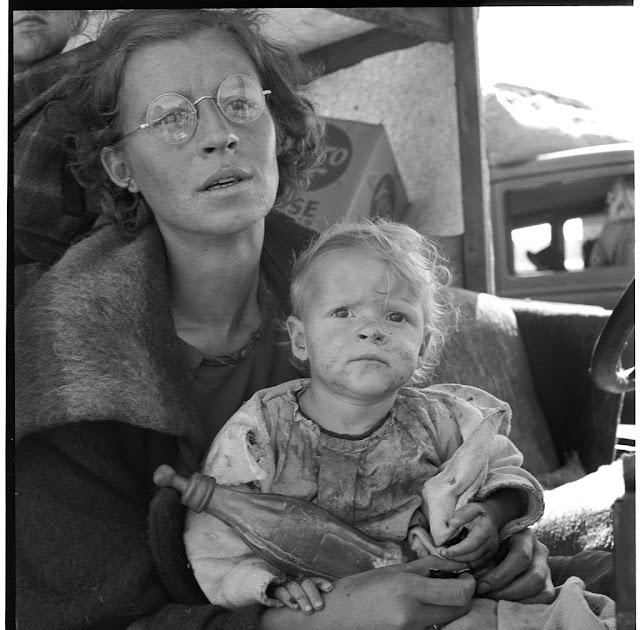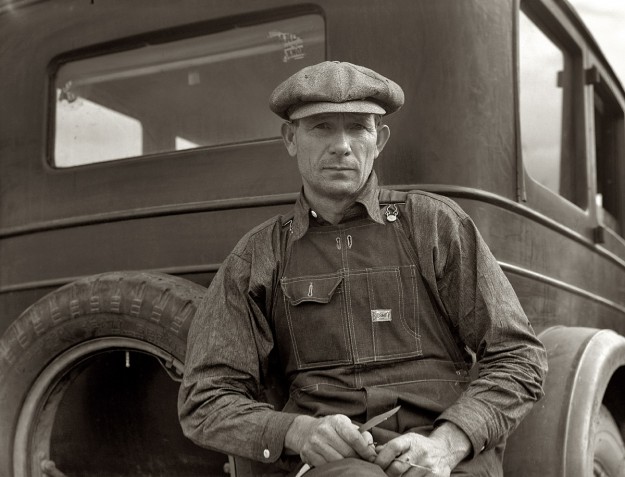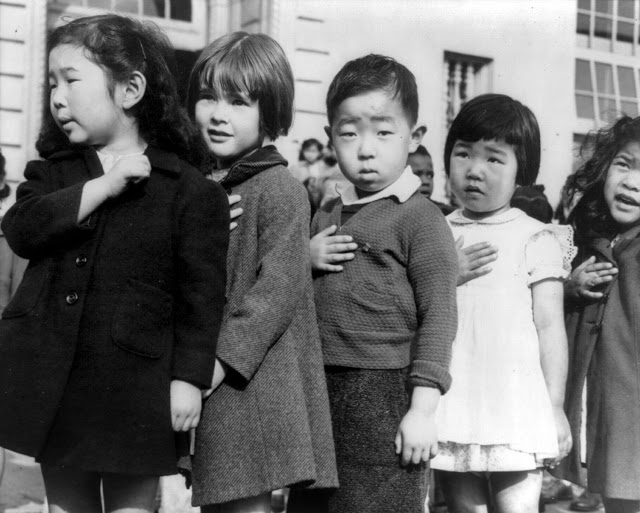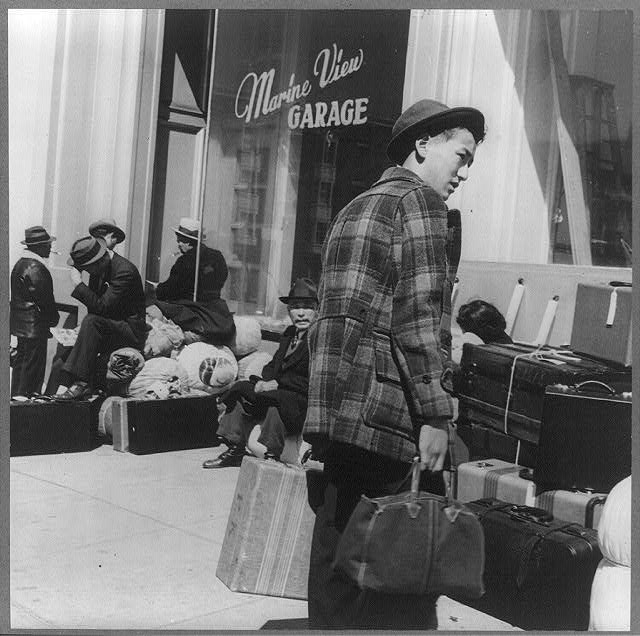"Photography takes an instant out of time, altering life
by holding it still."
~ Dorothea Lange
~ Dorothea Lange
Dorothea Lange was the most influential documentary photographer between 1930-1950.
Dorothea Nutzhorn (Lange) was born in Hoboken, New Jersey, on 26th May, 1895. At the age of seven, Dorothea contracted polio which left her with a permanent limp. After her German born father abandoned the family, Dorothea assumed her mother's maiden name.
Lange studied at the New York Training School for Teachers but changed her mind and decided to become a photographer. She worked in a Arnold Genthe's studio before studying photography under Clarence White at Columbia University. In 1918 Lange moved to San Francisco and the following year established her own portrait studio in the city.
Lange joined the California Camera Club where she met and influenced by the work of Consuelo Kanaga, a radical photojournalist with theSan Francisco Chronicle.
Lange's business was very successful until the Economic Depression that began after the Wall Street in 1929. followed. She then turned her attention to social realism and her photograph of a group of unemployed males, White Angel Breadline (1932), brought her to the attention of national critics and in 1934 Williard Van Dyke wrote an important article about her work in Camera Craft.
In 1935 Lange was invited by Roy Stryker to join the the federally sponsoredFarm Security Administration. This small group of photographers, including Esther Bubley, Marjory Collins, Mary Post Wolcott, Arthur Rothstein, Walker Evans, Russell Lee, Gordon Parks, Jack Delano, Charlotte Brooks, John Vachon, Carl Mydans, and Ben Shahn, were employed to publicize the conditions of the rural poor in America. Over the next few years Lange produced several notable photographs such as Migrant Mother (1936).
During this period Lange met Paul S. Taylor, a sociologist at the University of California. Taylor invited her to accompany him on his studies of migratory workers. Their book, An American Exodus: A Record of Human Erosion, appeared in 1939.
In 1942 Lange was hired by the War Relocation Authority to document the internment of Japenese-Americans during the Second World War. She was also employed by the Office of War Information (1943-45). Lange also covered the United Nations Conference in San Francisco for the State Department.
After the war Lange did several assignments for Life Magazine including Three Mormon Towns (1954) with Ansel Adams and Death of a Valley (1960). She also made photographic tours of Asia, South America and the Middle East. Dorothea Lange died of cancer on 11th October, 1965, just before the opening of her major retrospective exhibition at the Museum of Modern Art in New York City.
Dorothea Nutzhorn (Lange) was born in Hoboken, New Jersey, on 26th May, 1895. At the age of seven, Dorothea contracted polio which left her with a permanent limp. After her German born father abandoned the family, Dorothea assumed her mother's maiden name.
Lange studied at the New York Training School for Teachers but changed her mind and decided to become a photographer. She worked in a Arnold Genthe's studio before studying photography under Clarence White at Columbia University. In 1918 Lange moved to San Francisco and the following year established her own portrait studio in the city.
Lange joined the California Camera Club where she met and influenced by the work of Consuelo Kanaga, a radical photojournalist with theSan Francisco Chronicle.
Lange's business was very successful until the Economic Depression that began after the Wall Street in 1929. followed. She then turned her attention to social realism and her photograph of a group of unemployed males, White Angel Breadline (1932), brought her to the attention of national critics and in 1934 Williard Van Dyke wrote an important article about her work in Camera Craft.
In 1935 Lange was invited by Roy Stryker to join the the federally sponsoredFarm Security Administration. This small group of photographers, including Esther Bubley, Marjory Collins, Mary Post Wolcott, Arthur Rothstein, Walker Evans, Russell Lee, Gordon Parks, Jack Delano, Charlotte Brooks, John Vachon, Carl Mydans, and Ben Shahn, were employed to publicize the conditions of the rural poor in America. Over the next few years Lange produced several notable photographs such as Migrant Mother (1936).
During this period Lange met Paul S. Taylor, a sociologist at the University of California. Taylor invited her to accompany him on his studies of migratory workers. Their book, An American Exodus: A Record of Human Erosion, appeared in 1939.
In 1942 Lange was hired by the War Relocation Authority to document the internment of Japenese-Americans during the Second World War. She was also employed by the Office of War Information (1943-45). Lange also covered the United Nations Conference in San Francisco for the State Department.
After the war Lange did several assignments for Life Magazine including Three Mormon Towns (1954) with Ansel Adams and Death of a Valley (1960). She also made photographic tours of Asia, South America and the Middle East. Dorothea Lange died of cancer on 11th October, 1965, just before the opening of her major retrospective exhibition at the Museum of Modern Art in New York City.
[via spartacus.schoolnet.co.uk]

Country store on dirt road, Gordonton, North Carolina, 1939
Just arrived from Kansas. On highway going to potato harvest. Near Merrill,Klamath County,Oregon.
Photo of people on U.S. 99. Near Brawley, Imperial County. Homeless family of seven, walking the highway from Phoenix, Arizona, where they picked cotton. Bound for San Diego, where the father hopes to get on the relief because he once lived there, February 1939.
Children of turpentine worker near Cordele, Alabama. The father earns one dollar a day.
A grandmother from Oklahoma. She works in the California pea fields. Calipatria, California.
In a carrot pickers' camp, Imperial Valley, California. Woman from Broken Bow, Oklahoma. "Are you going to take my picture, wait till I get my hair combed".
On U.S. 99. Near Brawley, Imperial County. Homeless mother and youngest child of seven walking the highway from Phoenix, Arizona where they picked cotton. Bound for San Diego, where the father hopes to get on relief "because he once lived there."
Fifty-seven year old sharecropper woman. Hinds County, Mississippi. Thin dimes around the ankles to prevent headaches.
Father crippled with rheumatism. When well he works in a chair making factory. Orange County, North Carolina.
Lighthearted kids in Merrill FSA (Farm Security Administration) camp, Klamath County, Oregon.
Rural shacktown, near Klamath Falls, Oregon.
Young migrant mother has just finished washing. Merrill FSA (Farm Security Administration) camp, Klamath County, Oregon.
Young sharecropper and his first child. Hillside Farm. Person County, North Carolina.
Drought refugees from Oklahoma camping by the roadside. They hope to work in the cotton fields. The official at the border (California-Arizona) inspection service said that on this day,August 17,1936,twenty-three car loads and truck loads of migrant families out of the drought counties of Oklahoma and Arkansas had passed throught that station entering California up to 3 o’clock in the afternoon.
Migratory Boy.
Cotton worker in Sunday clothes. Near Blytheville, Arkansas.
Daughter of migrant Tennessee coal miner. Living in the American River Camp near Sacramento, California.
Ten year old son of tobacco sharecropper can do a "hand's work" at tobacco harvest time. Granville County, North Carolina
Napa Valley, California.
The Arnold children and mother on their newly fenced and newly cleared land. Note strawberry plants. Western Washington, Thurston County, Michigan Hill.
Mother and baby of family on the road. Tulelake, Siskiyou County, California.
Mississippi Delta Children
Tenant Farmer, North Carolina, 1939
The Worriator, Georgia, 1938
North Carolina, 1939.
San Francisco Social Security Office, 1938
Drought refugees from Abilene, Texas, following the crops of California as migratory workers. Said the father: “The finest people in this world live in Texas but I just can’t seem to accomplish nothin’ there. Two year drought, then a crop, then two years drought and so on. I got two brothers still trying to make it back there.”
A Japanese American unfurled this banner the day after the Pearl Harbor attack; Lange photographed it in March 1942, just prior to the man’s internment.
People of Japanese ancestry arriving at Tanforan Assembly Center, 1942
People of Japanese ancestry arriving at Tanforan Assembly Center, 1942
Manzanar Relocation Center, Manzanar, California, July 2, 1942. Grandfather and grandson of Japanese ancestry
Portrait of Lange
“A camera is a tool to learn to see without a camera.”
| ~Dorothea Lange |
Lange's most famous photograph: Nipomo, Calif. Mar. 1936. Migrant agricultural worker's family. Seven hungry children. Mother aged 32, the father is a native Californian. Destitute in a pea pickers camp, because of the failure of the early pea crop. These people had just sold their tent in order to buy food. Most of the 2,500 people in this camp were destitute.(notes made by Lange)
White Angel Breadline, San Francisco, 1933
"One should really use the camera as though tomorrow you'd be stricken blind."
~ Dorothea Lange
Just arrived from Kansas. On highway going to potato harvest. Near Merrill,Klamath County,Oregon.
Photo of people on U.S. 99. Near Brawley, Imperial County. Homeless family of seven, walking the highway from Phoenix, Arizona, where they picked cotton. Bound for San Diego, where the father hopes to get on the relief because he once lived there, February 1939.
Children of turpentine worker near Cordele, Alabama. The father earns one dollar a day.
A grandmother from Oklahoma. She works in the California pea fields. Calipatria, California.
In a carrot pickers' camp, Imperial Valley, California. Woman from Broken Bow, Oklahoma. "Are you going to take my picture, wait till I get my hair combed".
On U.S. 99. Near Brawley, Imperial County. Homeless mother and youngest child of seven walking the highway from Phoenix, Arizona where they picked cotton. Bound for San Diego, where the father hopes to get on relief "because he once lived there."
Pick a theme and work it to exhaustion... the subject must be something you truly love or truly hate.
~ Dorothea Lange
Fifty-seven year old sharecropper woman. Hinds County, Mississippi. Thin dimes around the ankles to prevent headaches.
Father crippled with rheumatism. When well he works in a chair making factory. Orange County, North Carolina.
Lighthearted kids in Merrill FSA (Farm Security Administration) camp, Klamath County, Oregon.
Rural shacktown, near Klamath Falls, Oregon.
Young migrant mother has just finished washing. Merrill FSA (Farm Security Administration) camp, Klamath County, Oregon.
Young sharecropper and his first child. Hillside Farm. Person County, North Carolina.
Drought refugees from Oklahoma camping by the roadside. They hope to work in the cotton fields. The official at the border (California-Arizona) inspection service said that on this day,August 17,1936,twenty-three car loads and truck loads of migrant families out of the drought counties of Oklahoma and Arkansas had passed throught that station entering California up to 3 o’clock in the afternoon.
Migratory Boy.
"While there is perhaps a province in which the photograph can tell us nothing more than what we see with our own eyes, there is another in which it proves to us how little our eyes permit us to see."
~ Dorothea Lange
Cotton worker in Sunday clothes. Near Blytheville, Arkansas.
Daughter of migrant Tennessee coal miner. Living in the American River Camp near Sacramento, California.
Ten year old son of tobacco sharecropper can do a "hand's work" at tobacco harvest time. Granville County, North Carolina
Napa Valley, California.
The Arnold children and mother on their newly fenced and newly cleared land. Note strawberry plants. Western Washington, Thurston County, Michigan Hill.
Mother and baby of family on the road. Tulelake, Siskiyou County, California.
Near Ontario, Malheur County, Oregon
Shoofly Tobacco, North Carolina, 1939Mississippi Delta Children
Tenant Farmer, North Carolina, 1939
The Worriator, Georgia, 1938
North Carolina, 1939.
Mississippi Cotton Patch, 1936
San Francisco Social Security Office, 1938
Children of Oklahoma drought refugee in migratory camp in California, 1936
Drought refugees from Abilene, Texas, following the crops of California as migratory workers. Said the father: “The finest people in this world live in Texas but I just can’t seem to accomplish nothin’ there. Two year drought, then a crop, then two years drought and so on. I got two brothers still trying to make it back there.”
First-graders, some of Japanese ancestry, at the Weill public school, San Francisco, Calif., pledging allegience to the United States flag. The evacuees of Japanese ancestry will be housed in War relocation authority centers for the duration of the war. April, 1942
A Japanese American unfurled this banner the day after the Pearl Harbor attack; Lange photographed it in March 1942, just prior to the man’s internment.
People of Japanese ancestry arriving at Tanforan Assembly Center, 1942
A young evacuee of Japanese ancestry waits with the family baggage
Young evacuees of Japanese ancestry awaiting their turn for baggage inspection upon arrival at assembly center, during WWII
Manzanar Relocation Center, Manzanar, California, July 2, 1942. Grandfather and grandson of Japanese ancestry
















































































Thanks for this page. It was a great way to get an overview of Lange's work and life.
ReplyDeleteThis page was great. A tribute to Lange, who, through her camera, showed us the fringe of America.
ReplyDeleteHer work so inspired me that I was compelled to paint many of the photographs. If you would care to view these paintings go to: http://fineartamerica.com/featured/on-the-road-1936-alyn-federico.html
Thank you so much for giving me the opportunity of seeing these photos (only a few of which I had seen before). They have affected me emotionally in an unexpected way, and have renewed my conviction that photography is a powerful medium for social awareness and change. Blessings.
ReplyDelete